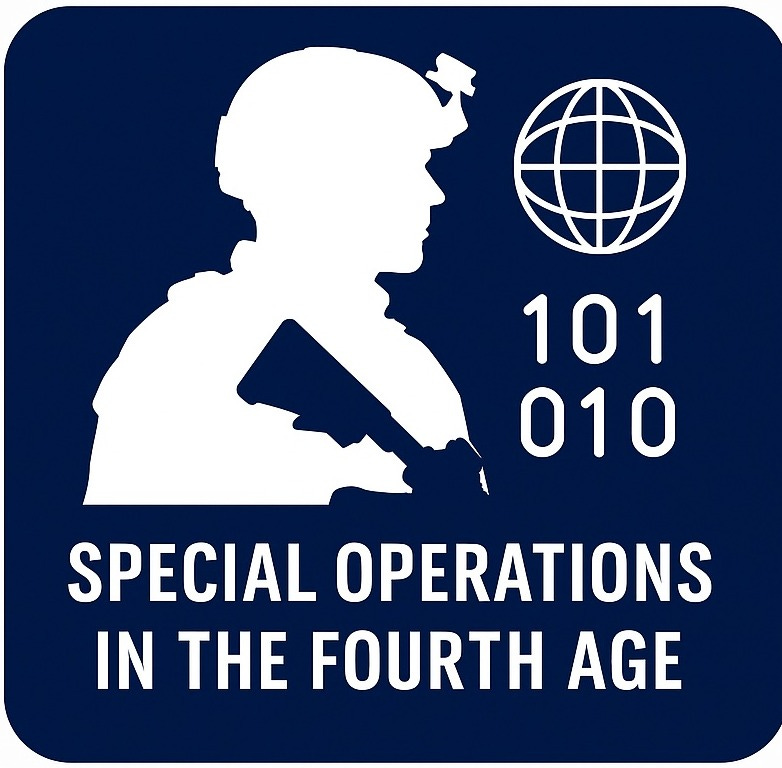Great Power, Greater Responsibility: Recasting Special Operations for the Fourth Age.
Day 6, Ep.10: Redesigning Special Operations for the Future.
Great Power, Greater Responsibility: Recasting Special Operations for the Fourth Age
By Dr. Isaiah (Ike) Wilson III
Editor’s Note:
This essay draws from a live dialogue I moderated with former Under Secretary of Defense for Policy Dr. Michelle Flournoy, as part of the 2021 Yale University SOFCOM—a convening of scholars, practitioners, and military professionals focused on redefining defense and strategy amid renewed great power competition.
What follows is an extension of the key themes we explored, from force structure to strategy, from innovation to identity. It’s written for those grappling not just with how we fight—but why, where, and toward what end.
Act I: Framing the Complication
Once again, we’re hearing it: Great Power Competition is back.
In the corridors of the Pentagon, the briefing decks of Combatant Commands, and the op-eds of foreign policy journals, the phrase has become almost reflexive—an organizing idea for how we must now think, plan, and invest.
But before we accept the slogan as strategy, let’s ask what it really demands of us.
Is today’s geopolitical landscape truly a redux of Cold War bipolarity?
Or is this something different—more fluid, more fragmented, and more deeply ‘compound’ in threat character?
And if so, what does it demand of the Special Operations Forces (SOF) enterprise?
What kind of leaders, strategies, and structures must we build—not to replay yesterday’s drama, but to shape tomorrow’s outcomes?
These are the questions that framed my conversation with Dr. Flournoy at Yale—and they remain just as urgent today.
Act II: Setting the Stage – The Fourth Age of SOF
We are no longer in an age of linear battlefields or simple binaries. We are operating in what I have termed the Fourth Age of SOF—a compound environment where cyber operations blend with kinetic, where state and non-state actors blur, and where “below threshold” aggression becomes the new modus operandi.
It is an age defined not just by new technologies, but by new combinations of threat.
What this means for SOF is profound.
It means that the tactical mastery of “door-kicking” must now be joined by strategic acuity in shaping, partnering, and influencing.
It means our force design must move from force expansion to force evolution—from size to sophistication, from quantity to quality, from activity to effect.
Act III: The Complication – What Nation Needs from SOF
In our conversation, I challenged Dr. Flournoy—and in turn, we both challenged the community—to consider what the Nation truly needs from its SOF in the coming decades.
Three points stood out:
Use and Utility – It’s not enough to ask where SOF can operate. We must ask why and to what effect. In an era where adversaries compete through positional advantage and influence—not occupation—SOF must become masters of the invisible terrain: legitimacy, trust, and information.
Posture and Structure – The current Global Posture Review must be ends-driven, not just efficiency-driven. We must resist the temptation to default to familiar footprints and instead align force posture with the actual geostrategic nexes of future conflict and deterrence.
Culture and Identity – The Fourth Age of SOF collides with the Fourth Tech Revolution. That means we need an operator who is not just agile on the battlefield, but adaptable across technological, ethical, and ideological fronts. SOF must become a crucible for innovation—not just hardware, but humanware.
Act IV: The Falling Action – Innovation, Integration, and Influence
Dr. Flournoy framed the real dilemma not as one of innovation itself, but of innovation adoption.
We have ideas. We have technologies. But we lack the institutional muscle memory to integrate them at speed, scale, and purpose.
She also underscored a powerful point: success in great power competition will not come from exquisite platforms alone—but from an exquisitely talented Total Force. That means rethinking PME, talent management, interagency integration, and yes—civilian intellectual investment.
SOF, in this context, becomes the “first in” not just tactically—but conceptually.
We must be the first to challenge the assumption that more tech equals more power.
The first to test new concepts of deterrence through non-kinetic means.
The first to build trust with partners not just through training, but by co-creating resilience.
Act V: The Climax – What Comes Next?
What comes next is not just a question for generals and strategists. It’s a civic question.
In my final exchange with Dr. Flournoy, we spoke of civil-military trust, of restoring legitimacy to alliances, of explaining to the American people why burden-sharing isn’t charity—it’s strategy.
We also spoke of the rising risk of over-relying on SOF as a solution to every hard problem.
Our response to this risk must be twofold:
Restraint in Tasking – SOF cannot become a panacea. Strategic leaders must resist the urge to “SOF-ify” all missions.
Investment in Identity – We must ground SOF in a renewed ethic of service—rooted in democratic accountability, ethical conduct, and the promise of “For Nation, Not Self.”
Final Words: Beyond ‘Force’
If we’re going to take Great Power Competition seriously, we must first take great responsibility for how we define and deploy power.
That begins with SOF. But it doesn't end there.
It extends to how we educate the force, how we organize for agility, and how we ensure that the tools of influence remain subordinate to values, not the other way around.
This was the soul of our dialogue at Yale. And it must become the spine of our strategy going forward.
Great power alone does not make a nation great.
How we use it—that’s the real test.
Subscribe to Compound Security, Unlocked for more reflections like this—where strategy meets soul, and defense meets democracy.



